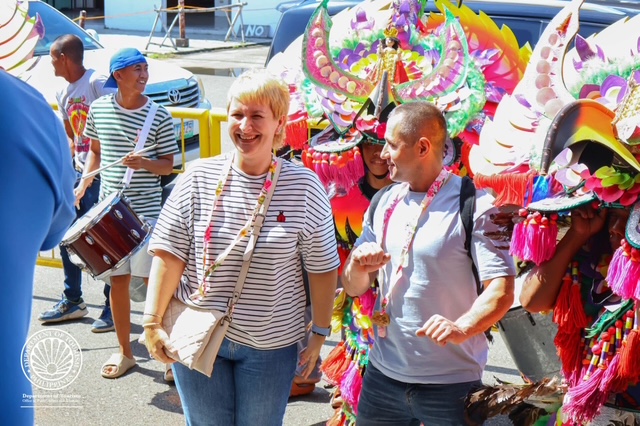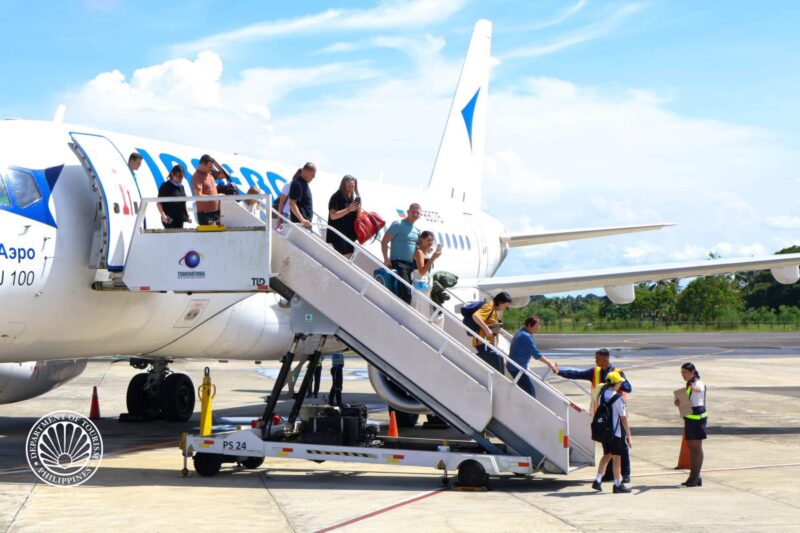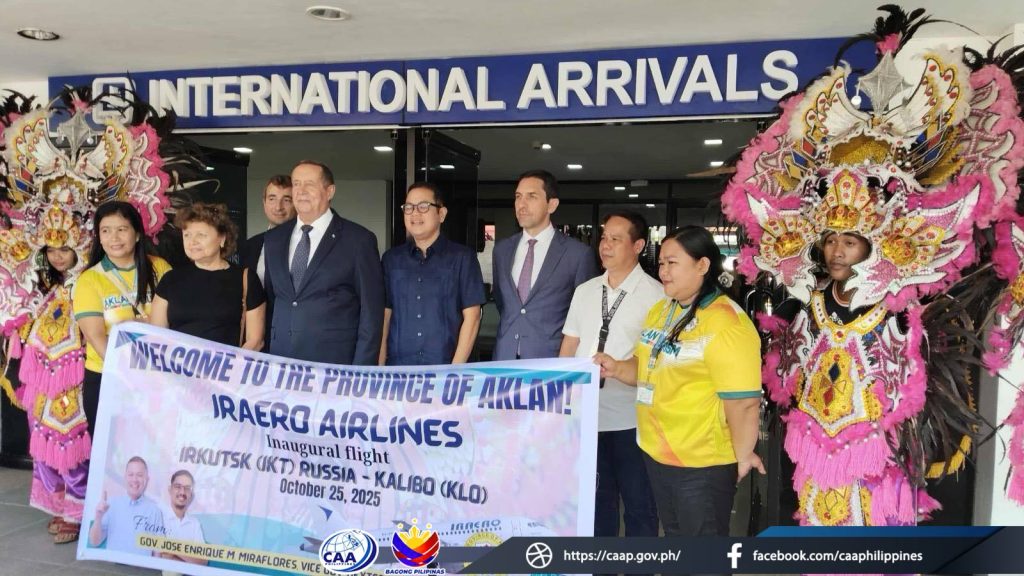Every year, when the Russian winter starts to bite, travelers from across Russia look for a sunny escape. This year, that escape happens to be Boracay. On October 25, 2025, a new direct flight from Irkutsk, Russia to Kalibo, Aklan officially opened a travel bridge between Siberia and the Philippines’ most famous island paradise — and it’s already drawing couples and families ready to “winter” by the beach.
A Warm Filipino Welcome
Nearly 100 Russian tourists stepped off IrAero Airlines’ inaugural flight to the Philippines at Kalibo International Airport. They were greeted the Filipino way — with local dancers, drumbeats, and colorful cultural performances that captured the island’s festive spirit.
The flight marks the first-ever direct connection between Irkutsk and the Philippines, solidifying ties between the two countries and creating new opportunities for tourism. According to both the Department of Tourism (DOT) and the Civil Aviation Authority of the Philippines (CAAP), 95 passengers took part in the maiden trip, many of them young couples and families heading straight for Boracay.
CAAP Director General Lt. Gen. Raul Del Rosario (Ret.) called the event a “milestone for regional connectivity,” emphasizing how it will boost tourism in Western Visayas while fostering cultural and economic exchanges between Russia and the Philippines.

Tourism Boost Expected
DOT-Region 6 Director Crisanta Marlene P. Rodriguez said they are expecting a “modest year-end lift” in Russian arrivals thanks to IrAero’s flights. The airline has scheduled twice-weekly flights between Irkutsk and Kalibo through December 2025, with projections of around 2,600 to 3,600 new Russian visitors before year-end, depending on load factors and aircraft capacity.
Looking ahead, the DOT forecasts that Russian arrivals could reach 15,000 to 19,000 in 2026 if IrAero continues its service year-round. That’s a significant boost considering that, before the pandemic, Russia consistently ranked among Boracay’s top 10–15 source markets.
Russians Returning in Strong Numbers
The Malay Tourism Office reports that 14,669 Russians have already visited Boracay in 2025, surpassing pre-pandemic levels of 12,784 in 2019. For a country that has faced currency challenges and travel restrictions due to the war in Ukraine, this rebound is impressive.
Before the ruble crash in 2014, Russia was considered an “opportunity market” for Philippine tourism, showing consistent 10% annual growth. But economic sanctions and global uncertainty hit Russian outbound travel hard. Despite this, the Philippines continues to see a slow but steady return of Russian tourists — with 20,023 Russian visitors recorded nationwide from January to September 2025, up 11.5% from the same period last year.
IrAero Airlines: The New Bridge from Siberia to the Tropics
IrAero Airlines, headquartered in Irkutsk, is leading this new wave of travel. The airline will operate regular flights between Irkutsk and Kalibo every Saturday until March 2026, with a short layover in Guilin, China. A second route from Khabarovsk to Kalibo also launched on October 28, running every Tuesday until March 26, 2026.
Both routes use the Sukhoi Superjet 100 (SSJ100) — a 100-seater regional aircraft known for its comfort and efficiency. These flights are perfectly timed for Russia’s harsh winter months, giving travelers the chance to escape the snow and experience Boracay’s turquoise waters and tropical sunshine.

Competing with Thailand, Egypt, and the UAE
According to Russian travel agency Anex Tour, the top winter destinations for Russians this season are Thailand, Egypt, the United Arab Emirates, Sri Lanka, and Goa in India. Now, Boracay is joining that list.
Aklan Governor Jose Enrique “Joen” Miraflores said that by the end of the year, they expect over 15,000 Russian visitors to arrive in Boracay. “Based on data from January to September, we’ve already received 10,000 Russian visitors. With these new flights, our tourism and economic relations with Russia have been strengthened,” he said.
Building Bridges Beyond Tourism
At the inaugural ceremony, Russian Ambassador to the Philippines Marat Pavlov emphasized that the new air link isn’t just about tourism — it’s about cultural exchange and cooperation. He expressed hope that, in return, Filipinos will also have the opportunity to explore Russia’s natural wonders, including the world-famous Lake Baikal — the largest freshwater lake on Earth, located near Irkutsk.
Currently, there are no other direct flights between Russia and the Philippines. Travelers usually transit through Shanghai, Hong Kong, or Middle Eastern hubs to reach Manila or Cebu. In the past, Philippine Airlines operated seasonal charter flights from Vladivostok to Kalibo and Cebu, which were particularly popular during winter months. Aeroflot, Russia’s flag carrier, also maintains a code-share agreement with PAL, though it does not operate direct routes.

Why Russians Love Boracay
It’s easy to see why Boracay appeals to Russian travelers. The island offers everything a winter-weary traveler craves — sunshine, sand, nightlife, and world-class hospitality. Unlike crowded beach destinations in Southeast Asia, Boracay combines luxury resorts with authentic local charm.
For many Russians, escaping sub-zero temperatures for a balmy 30°C tropical island is more than just a vacation — it’s a seasonal migration. Families spend months in warm destinations during Russia’s coldest period, a trend locals call “wintering abroad.” Boracay’s relatively low cost of living, wide selection of beachfront villas, and vibrant expat community make it an ideal choice for this lifestyle.
The Economic Ripple Effect
The arrival of Russian tourists brings more than just hotel bookings. Local businesses — from dive shops and restaurants to souvenir stores — are already feeling the positive impact. The influx of long-stay visitors during the winter months helps sustain tourism-dependent communities during what used to be Boracay’s quieter off-peak season.
DOT-Region 6 is optimistic that these direct flights will spark new investments in hospitality and infrastructure in Aklan and the surrounding provinces. Improved air access often encourages new hotel developments, better transport links, and increased job opportunities for locals.
Boracay’s Recovery Story
This development is also part of Boracay’s ongoing recovery story. After the 2018 island rehabilitation and the tourism slump caused by the pandemic, Boracay has bounced back stronger — cleaner, greener, and more regulated. Now, with new international routes opening, it’s reasserting itself as one of Asia’s most desirable beach destinations.
The return of Russian tourists symbolizes confidence in the island’s appeal and infrastructure. It’s also proof that global travelers are once again looking beyond traditional destinations for new experiences.
A Win-Win Partnership
For the Philippines, attracting high-value markets like Russia aligns perfectly with the government’s tourism diversification goals. Russians are known to spend generously on accommodations, dining, and leisure activities — a boost to local economies.
Meanwhile, for Russians, this direct connection offers an easy, affordable gateway to one of Southeast Asia’s best islands without the hassle of multi-stop flights. It also strengthens cultural ties between two countries with growing interest in each other’s heritage and landscapes.
Looking Ahead
With two IrAero routes now operational and the possibility of more in the future, tourism officials see this as just the beginning. If these flights continue beyond March 2026, Boracay could see a steady stream of Russian “snowbirds” each winter.
The move also positions Kalibo International Airport as a growing regional hub, potentially attracting more charter and direct flights from other non-traditional markets like Kazakhstan, Mongolia, and Eastern Europe.
The Bottom Line
The new IrAero flights are more than just a travel route — they represent a connection between two worlds: the frozen expanses of Siberia and the tropical warmth of Boracay. As more Russian families trade snow boots for flip-flops, this partnership could redefine Boracay’s visitor landscape for years to come.
For now, as hundreds of Russians prepare to “winter” on the island, the sound of Russian accents mingling with Filipino hospitality is proof enough — Boracay is officially back on the global map.
